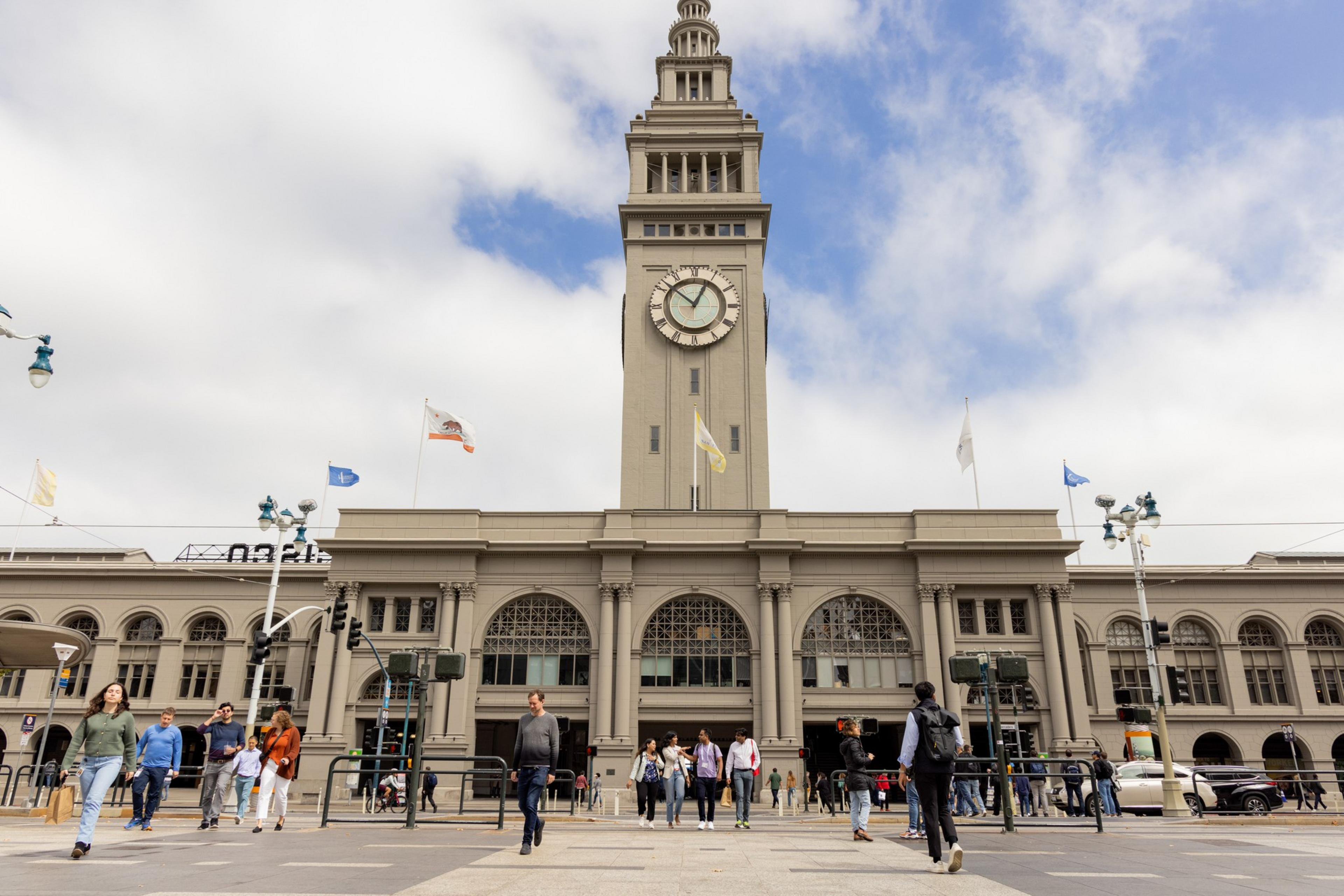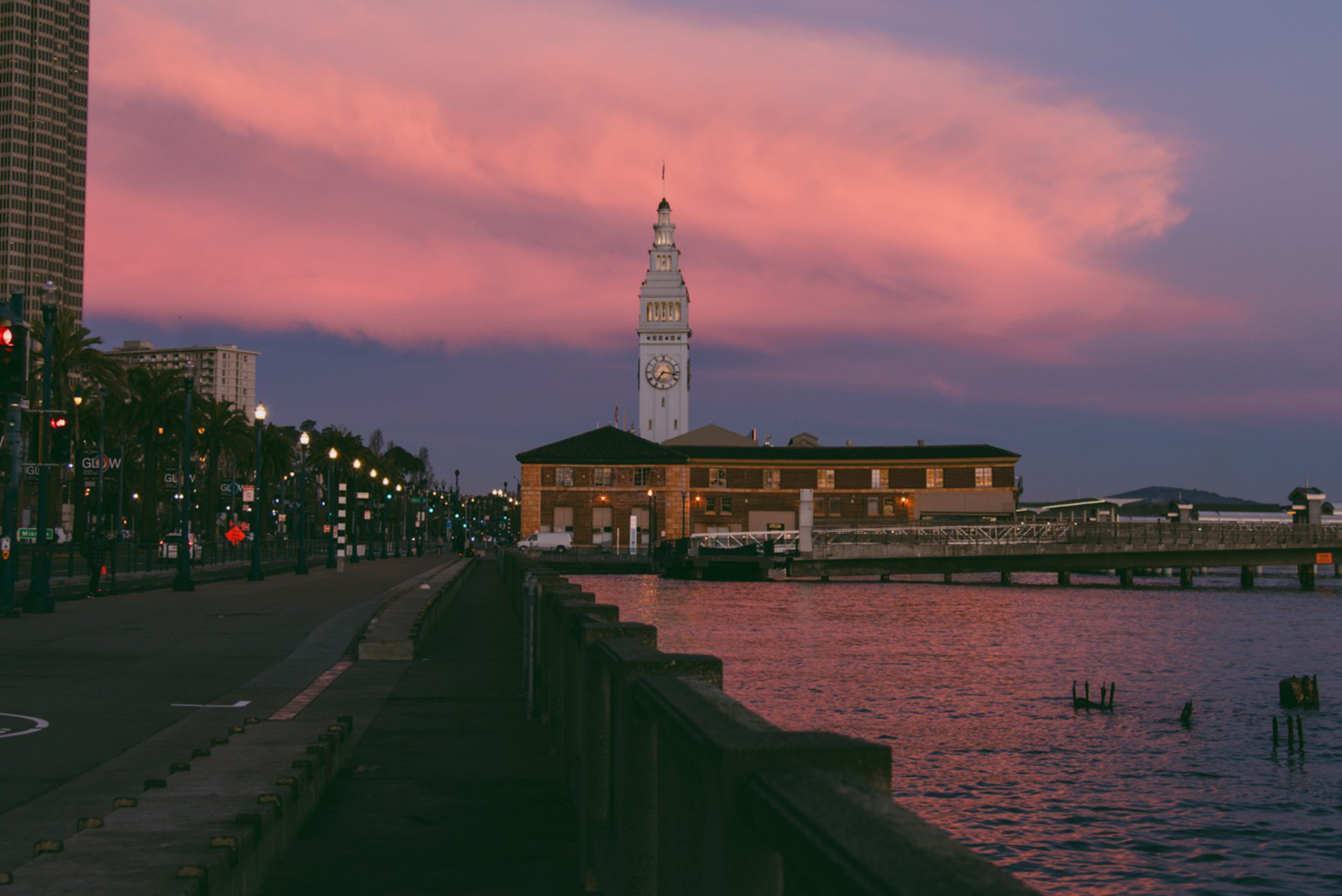In a second-story room with sweeping views of boats skimming across the water and the Bay Bridge stretching into the distance, Jane Connors makes a declaration: “I think the Ferry Building is the great hope of San Francisco.”
Of course, this comes from the woman who has served as the famous food hall’s general manager — or “fairy godmother,” as she likes to say — since 2003. So, yes, she might be biased.
But she also might be right.
The grandiose statement came in early September, when Connors and the rest of the Ferry Building management team had victoriously and strategically filled almost every one of the building’s retail slots. This was a big turnaround from early 2021, when many of the food hall’s most prominent spaces were dark. Today, there is just one empty storefront: the west-facing space formerly occupied by MarketBar, which the owner says is in lease negotiations with a potential tenant. Rumor has it a cooking school may enter the mix.
Beyond just filling the building’s 57 retail and restaurant spaces, Connors and her team have successfully ushered the Ferry Building into a new era. Today, the building’s lineup of restaurants is more diverse than ever, offering the likes of spicy Cambodian noodles, Roman-style pizza, Mexican-Filipino street food, Jamaican patties, and traditional French buckwheat crepes. In short, it’s a true slice of the city, all packed into 65,000 square feet of waterfront space.
‘It was the place to be’
You could argue that the Ferry Building started out as the city’s great hope — a Cinderella story constructed from the bones of an abandoned landmark. In the post-pandemic era, it has been up to Connors to build it back.
The building, constructed in 1898, reemerged in 2003 after a $90 million renovation as the bright and airy food-lovers paradise (opens in new tab) we know today. Back then, the San Francisco Chronicle (opens in new tab) predicted that it would occupy a prominent space in the city’s culinary scene: “Along the way, they’ll see a food hall that the project’s architect boasts will be a showpiece for Bay Area foodies.”

Opening tenants included cheesemaker Cowgirl Creamery and Tsar Nicolai, the Sacramento Valley-based caviar company, as well as the sit-down restaurant MarketBar. A second wave of openings included Traci Des Jardins’ restaurant Mijita Cocina Mexicana, which debuted in 2005.
The early-2000s Ferry Building was indeed “a really big deal,” says Des Jardins. “There was camaraderie, a sense of community and family borrowing stuff,” she says. “It was the place to be. It was a great vibe.”
The building continued to attract top-shelf talent over the next decade, including anchor tenants such as Charles Phan’s Slanted Door. But as leases began to run out in early 2020, several high-profile tenants, including Mijita (opens in new tab) and MarketBar (opens in new tab), vacated, citing an inability to come to terms for renewal.
‘The San Francisco I fell in love with’
Then the pandemic hit. Due to its status as a transportation terminal, the Ferry Building remained mostly open (opens in new tab). But that didn’t prevent an exodus of businesses, including Vive La Tarte, San Francisco Fish Company, and Farm Fresh to You. Chef Tanya Holland’s celebrated soul food restaurant Brown Sugar Kitchen had closed in January 2020, and the Slanted Door went dark during the early days of the pandemic and stayed that way for four years, though Phan wouldn’t confirm a permanent closure (opens in new tab) until May 2024.
The Ferry Building brought in short-term tenants that included the art pop-up Creativity Explored (opens in new tab) and a pierogi vendor (opens in new tab) who raised money for the war in Ukraine, but by early 2021, several of the largest spaces sat empty.


The turnaround started in earnest about a year later, when a slew of established Bay Area restaurants began to move in. Patrick Acaso, who operates two locations of French bakery Le Marias, debuted Grande Crêperie in the spring of 2022. The counter-service restaurant serves traditional Brittany-style buckwheat crepes — a nod to Acaso’s childhood summers on the French coast. Filipino-Mexican street-food vendor Señor Sisig opened its Ferry Building outpost five months later, followed by butcher stop Fatted Calf and the restaurant Reem’s from James Beard Award-nominated chef Reem Assil. A16’s casual spinoff opened in early 2024, and Nite Yun’s Cambodian restaurant Lunette joined the lineup in June.
For Yun, the Ferry Building offered a platform unlike any other, where she could put an overlooked cuisine on a grand stage. “To be able to showcase Cambodian food to people from all walks of life? That’s pretty wild,” she says.
Acaso and Yun agree that workweek foot traffic has yet to return to pre-pandemic levels, but both say business levels are moving in the right direction. “I feel very hopeful,” Yun says. “This is the San Francisco I fell in love with. I feel very happy to see how buzzy and energetic it is.”
‘Like winning the food entrepreneurial lottery’
There’s more than just luck and an unbeatable Embarcadero location behind the building’s comeback.
Connors and her team strive for a tenant mix that makes the building a “full, seven-day-a-week shopping experience” — a place to pick up groceries, cookware, and souvenirs, alongside prepared meals and snacks. “One of the No. 1 things our shoppers were telling us was we really need a fishmonger,” Connors says. This led her team to recruit beloved Nopa chef Laurence Jossel and fishmonger Water2Table to open Nopa Fish, which will debut early next year in the former San Francisco Fish Company space.

The Ferry Building is also leaning on the five kiosks on the north side of its facade to act as “plug-and-play” spaces for vendors whose food requires minimal prep. Jamaican restaurant Peaches Patties, which operated as a catering company for nine years, recently put down roots in one of these spaces.
Peaches Patties owner Shani Jones is one of four current Ferry Building tenants who graduated from the food-business incubator La Cocina, along with Tiffany Carter of Palmvy, Assil, and Yun. Connors says the growing number of tenants who graduated from the incubator program is no accident, as it is looking to help people who are “primed for the next step.”
Additional high-profile incoming tenants include Sorrel chef-owner Alex Hong, who will open a restaurant in the former Slanted Door space early next year. Bernal Cutlery, the city’s premier knife store, will also open an outpost in the building. A deal to fill the one remaining restaurant vacancy has yet to be inked, but Connors hints that there may be news soon. Whoever it is will get more than a fresh set of keys to the historic building. For the right business, Connors says, “it’s like winning the food entrepreneurial lottery.”
